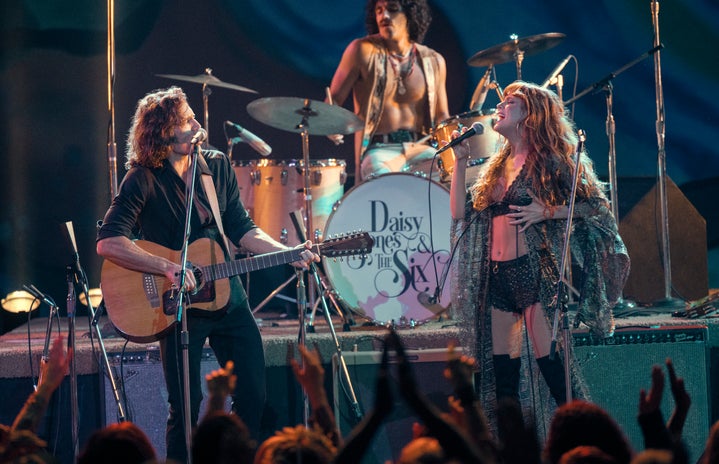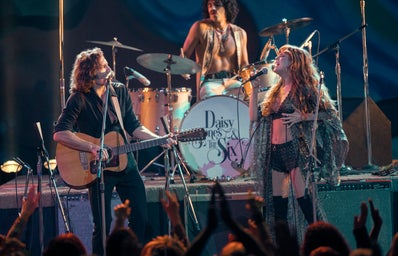In 2020, I read Taylor Jenkins Reid’s novel Daisy Jones & The Six for the first time. While its interview-style format initially sparked my interest, I was also drawn to the wild-haired portrait of Daisy Jones on the cover.
It was the book I had been looking for all summer, and all I wanted to do was immerse myself in the exciting, chaotic and intoxicating world of ’70s rock ‘n’ roll. I read it in two days, and Daisy Jones & The Six quickly became one of the best books I read that year.
Eventually, I heard the news that Prime Video was adapting it as a miniseries, and when one of your favourite books gets adapted for the screen, you become the world’s most annoying critic. After all, book adaptations rarely get it right. I remember thinking, is Riley Keough really the perfect Daisy Jones? Are they actually recording the album? And what if they completely scrap the most important scenes from the book?
Luckily, Daisy Jones & The Six turned out to be a pleasant surprise. They made a few changes (which is expected), but they still listened to the fans.
Loosely based on the romance between Fleetwood Mac’s Stevie Nicks and Lindsey Buckingham, the story follows the rise and fall of the fictional 1970s rock band Daisy Jones & The Six and unpacks what led to their abrupt split after performing in Chicago on July 12, 1979. Specifically, it follows the complicated relationship between lead band members Billy Dunne and Daisy Jones.
At the beginning of the novel, the “author’s note” reveals that the book is an “oral history” of the band’s success and is made up of interviews with former and current members of the band, as well as friends, family and the industry elite who worked with them. It’s also the first and only time the band members have agreed to speak about their past.
The miniseries follows the same format, and by adopting the same sense of realism as the novel, I felt like I was watching a documentary about a real band. As it cuts back and forth between present-day interviews and scenes that reimagine key moments from the band’s rise to fame, you can’t help but wish Daisy Jones & The Six was real.
The show’s star-studded cast didn’t disappoint me either. The band consists of Riley Keough (Daisy Jones), Sam Claflin (Billy Dunne), Will Harrison (Graham Dunne), Suki Waterhouse (Karen Sirko), Sebastian Chacon (Warren Rhodes) and Josh Whitehouse (Eddie Roundtree). The series also features fan favourite Camila Alvarez (Camila Morrone), record producer Teddy Price (Tom Wright) and Simone Jackson (Nabiyah Be).
Despite its genius casting, the show’s music is what truly brought the band to life. The lyrics from the book were adapted into eleven original songs by Blake Mills and a group of other notable collaborators. These songs, which were performed by the actors who participated in an 18-month band camp before filming began, were released on their album Aurora back in March. Soon enough, Daisy Jones & The Six became the first fictional band to hit No. 1 on the charts.
While Sam Claflin and Riley Keough do not consider themselves to be professional singers, they did an excellent job on the album. It prioritizes small yet powerful production details to honour the sound of the most renowned rock bands from the 70s. As I listen to Aurora while writing this, I can tell that the album was written by a group of extremely talented and detail-oriented musicians who care about Reid’s story just as much as the fans do.
Besides the music, the show is clearly well-made. The costumes, hairstyles and set designs are an ode to the music scene in 1970s California. The only detail that I wasn’t a huge fan of was how the show “aged” some of the band members in the interview scenes. Daisy didn’t look like she had really aged at all, and Karen’s abrupt hairstyle change seemed like a lazy way to signify that decades had passed in between scenes.
Like practically every other book adaptation, the show made a few plot changes. A major detail is that they completely eliminated the sixth member of the band, Pete Loving. Showrunner Scott Neustadter says that writing Pete out of the series allowed them to give the characters the depth they deserved, and to cover up this plot hole, they decided to make Camila the sixth “unseen” member of the band instead.
Other changes are scattered throughout the series. For example, some fans might be disappointed that a particularly important scene from the book was left out of the finale (specifically the one between Camila and Daisy). While I was disappointed with this change, I can’t blame them. It’s impossible to include every book detail in an adaptation, and even though it was different from what I imagined, I think it all worked out well in the end.
If you’re a music lover looking for an entertaining series to binge, I highly recommend watching Daisy Jones & The Six. As a fan of the novel, it’s clear that the creators have not forgotten that Daisy Jones & The Six is held together by its complicated, frustrating and undeniably lovable characters. It also conveys an important message — relationships are messy, imperfect and complex, and even the biggest bands in the world can be torn apart by love.


